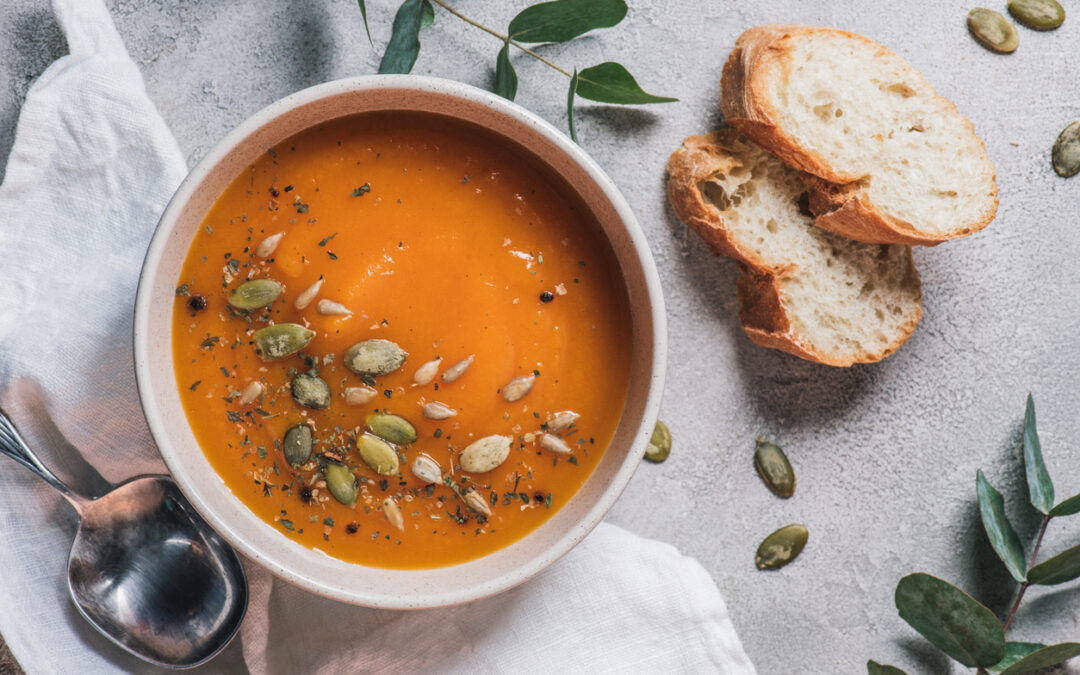
by Jen Owen, N.P. | Nov 19, 2020 | Food Medicine, Seasonal Health
It’s almost Thanksgiving and time for some good eats!
A lot of the Thanksgiving foods are high in sugar and saturated fats. I like to add in some healthier options whenever possible.
#1: Pumpkin Soup
On Thanksgiving, I always get hungry in the afternoon. My family usually eats the large meal around 4-5pm. By 1pm, I’m starving.
This soup can be made ahead so all you have to do is warm it up when you’re ready.
I’ve had the Vegetarian Times Complete Thanksgiving Cookbook for years and I’ve made the pumpkin soup many times.
It’s the perfect snack for Thanksgiving and keeps you in the fall mood.
Ingredients:
1 tablespoon olive oil
1 teaspoon ground cumin
1 teaspoon ground coriander
1/4 teaspoon cinnamon
2 cups diced yellow onion
2 cups fresh pumpkin puree or one 15-ounce can pumpkin
6 cups vegetable stock
Salt to taste
1/4 cup thinly sliced scallion
1/2 cup toasted croutons
Preparation:
Heat oil in a 3 1/2-quart saucepan. Add dry spices, stirring to warm, but not browning, about 1 minute.
Add onion, stirring to coat. Saute over medium heat until onion if soft but not brown, about 5 minutes. Add pumpkin puree and stock; stir to mix. Bring to a boil. Lower heat to a simmer. Simmer, covered, until soup is slightly thickened and flavors are melded, about 20 to 25 minutes. Salt to taste.
Pour soup into a large bowl. Puree in batches in a food processor or blender. Return to pan. Heat before serving. Garnish with scallions or croutons.
Serves 8.
#2: Shredded Brussels Sprouts Salad
This one is SO good! And, it’s pretty, too. It comes from blogger, Iowa Girl Eats.
It makes a lovely side dish for Thanksgiving and brings a little veggies on board.
For dairy free, it’s still quite good without the cheese.
Ingredients:
12oz brussels sprouts, tough outer leaves pulled away
1/4 cup dried cranberries
1/4 cup Fisher Naturals Pecan Halves, roughly chopped
1/4 cup gorgonzola cheese crumbles
1 pear, chopped
2 jumbo shallots, thinly sliced
1/4 cup extra virgin olive oil
For the Maple-Balsamic Vinaigrette:
2 Tablespoons extra virgin olive oil
2 Tablespoons balsamic vinegar
1 Tablespoon maple syrup (not pancake syrup)
1 teaspoon Dijon mustard
salt and pepper
Preparation:
Using a very sharp knife, thinly shred brussels sprouts while holding onto the core end then discard cores and add shredded sprouts to a large bowl with dried cranberries, chopped pecans, gorgonzola cheese, and chopped pears. Set aside.
Heat extra virgin olive oil in a large skillet over medium-high heat. Add half the shallots then fry until golden brown, 2-3 minutes, stirring occasionally. Scoop onto a paper towel-lined plate to drain then repeat with remaining shallots. Sprinkle with salt then let cool slightly.
Add ingredients for Maple Balsamic Vinaigrette together in a jar then shake to combine. Pour over salad then toss to coat. Add fried shallots then toss to combine, and then serve.
Serves 4-6.
#3: Maple & Cayenne Roasted Acorn Squash with Brown Butter Hazelnuts
It’s not easy to find a squash recipe that actually tastes really good.
Here you go with this one from Oregon blogger, Dishing Up The Dirt.
It’s the perfect combination of sweet, salty, and savory.
The first time I made it, I didn’t have any hazelnuts. I used almonds and they worked fine.
You don’t need as much butter as the recipe suggests. I would cut it in 1/2 at least. I also think you could simply toast the nuts and it would still be delicious.
Ingredients:
1 medium sized acorn squash, cored and cut into wedges (no need to peel)
2 tablespoons olive oil
1/4 cup pure maple syrup
1/8 teaspoon cayenne pepper
pinch of salt
1/2 cup hazelnuts, coarsely chopped
1/4 cup unsalted butter
1/4 cup parsley, minced
Preparation:
Preheat the oven to 400F.
In a large bowl toss the squash wedges with the maple syrup, oil, cayenne and pinch of salt until evenly coated. Place the squash in a single layer on a rimmed baking sheet and bake in the oven until tender and caramelized, about 35-45 minutes. Flip the squash halfway through cooking.
While the squash roasts prepare your brown butter hazelnuts. Heat a small dry skillet over medium heat. Add the hazelnuts and cook, shaking the pan often, until they are lightly browned and fragrant, about 5 minutes. Add the butter and cook, stirring frequently until the butter is golden brown and flecked with brown bits, about 5 minutes. Pour the hazelnut mixture into a bowl and set aside.
Sprinkle the roasted squash with the brown butter hazelnuts and minced parsley and serve warm.
Serves 4.
Hope these bring some new and healthier options for your Thanksgiving this year.
What are your favorite healthier recipes for the holiday?
Please share them in the comments below.
Happy Thanksgiving!
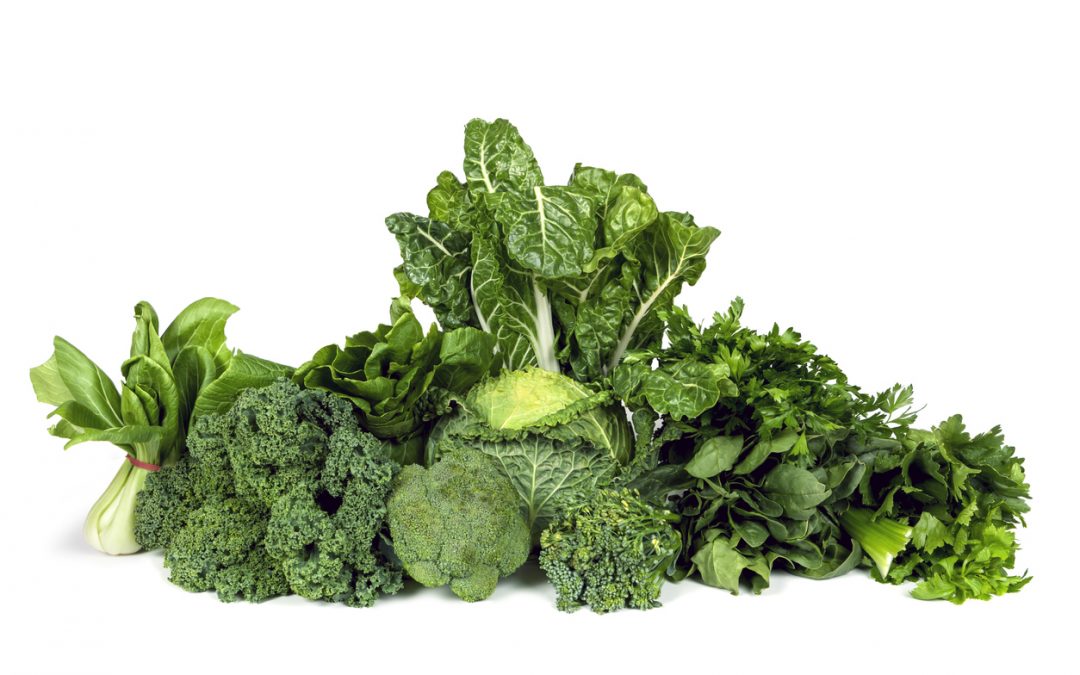
by Jen Owen, N.P. | Jul 23, 2020 | Food Medicine
Last week, I talked about Magnesium.
This week, I wanted to talk about calcium and specifically how to get it through your diet without always looking to dairy products. Yes, dairy products do contain high amounts of calcium and so do many other foods.
Dairy can tend to be a pro-inflammatory food for a lot of people, so I think it’s important to be incorporating other food sources to keep our bones strong, as well.
Non-Dairy Food with Decent Calcium Content
Vegetables/Fruits
Broccoli
Kale
Watercress
Chard
Collards
Dandelion Greens
Mustard Greens
Spinach
Turnip Greens
Endive
Okra
Bok Choy
Oranges
Figs, dried
Beans
Chickpeas
Lentils
Soybeans (tofu, soy milk)
White beans
Nuts & Seeds
Almonds
Brazil nuts
Sesame seeds
Walnuts
Seafood/Poultry
Egg Yolk
Chicken bone broth
Mackerel
Salmon
Sardines
Rainbow trout
Kelp
Others
Brewer’s yeast
Blackstrap molasses
Carob
Although this is not an exhaustive list, it’s a pretty good one. How many calcium foods are part of your regular diet?
I’m a big fan of eating your nutrients and I teach all my patients to do this as much as possible. You can become a patient in my Portland Clinic or see me for Whole Life Coaching & Consulting if you don’t live near.
Be sure to share this post with family and friends so they make sure they’re eating enough calcium, too!
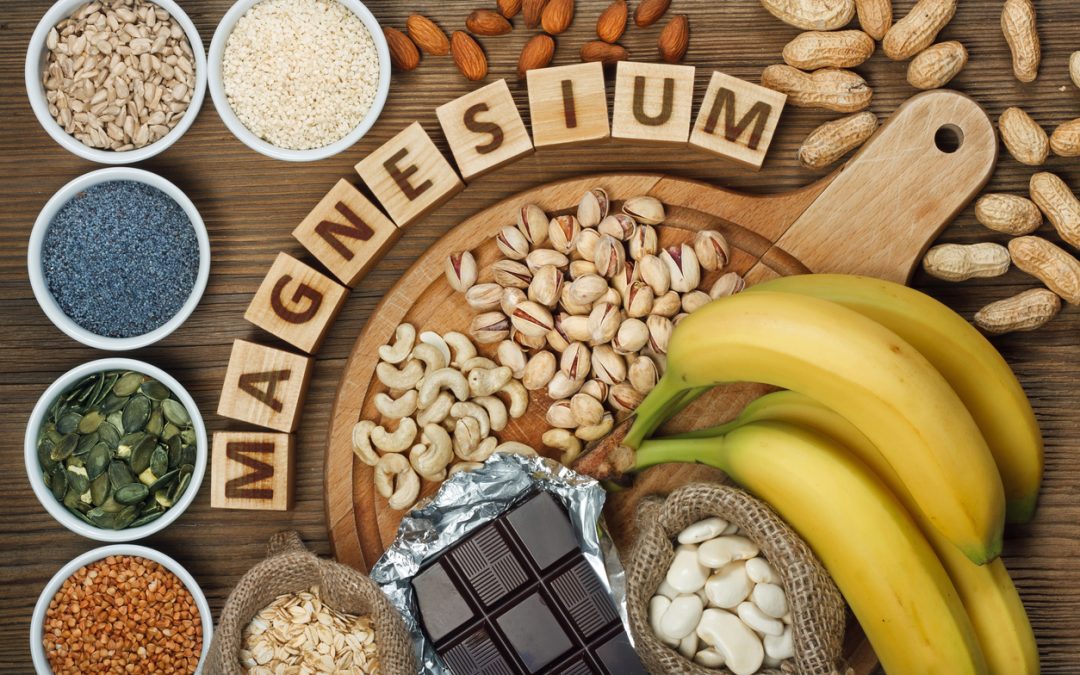
by Jen Owen, N.P. | Jul 16, 2020 | Food Medicine
Magnesium is one of my favorite and most useful supplements. It does so many things!
Magnesium works with calcium to keep the bones strong. It helps muscles contract and nerves send and receive signals. It helps us maintain a steady heart beat and a strong immune system. It even seems to help regulate blood sugar.
I use magnesium often with my patients. It’s been helpful for many symptoms, including muscle aches, restless legs, PMS, migraine headache prevention, pain syndromes like fibromyalgia, insomnia, and much more.
Of course, I’d love it if you tried to eat more magnesium first. Nutrients in food are the most bioavailable to our bodies. Foods high in magnesium include almonds, spinach, cashews, beans, potatoes, peanuts, brown rice, salmon, halibut, bananas, dark chocolate (whoop!) and avocado, just to name a few.
The Recommended Daily Allowance (RDA) of magnesium is:
~Men: 400-420mg
~Women: 310-320mg
Consider doing a food diary for a few days and see how much magnesium you are taking in. There are many great websites that list the magnesium components of foods and some apps, as well, if you search for them.
If you do have symptoms and you want to try a magnesium supplement, the dose depends on the size of the person and the condition being treated. For general body aches and pains, I recommend 120mg of magnesium glycinate twice daily.
Magnesium citrate is more widely known for the treatment of constipation. This is not a form of magnesium I recommend people use regularly due to possibility of dehydration and electrolyte imbalances. If you do struggle with constipation, magnesium citrate can be a game changer to remind the bowels how to move properly.
Forms of magnesium such as glycinate, fumurate, and malate will have less effect on the bowel and are usually better tolerated.
It is possible to overdose on magnesium, so always use the least possible amount to treat the symptoms and no more. As always, it’s best to check with your healthcare provider before starting any new supplements.
If you live in Portland, I’d be happy to see you in my clinic and discuss whether magnesium could be a great addition to your health regimen. For those not near me, I offer Whole Life Coaching.
I hope paying more attention to the magnesium you consume will bring you even more energy and vitality!
If you liked this article, please sign-up for our weekly newsletter for tips like this right to your inbox.
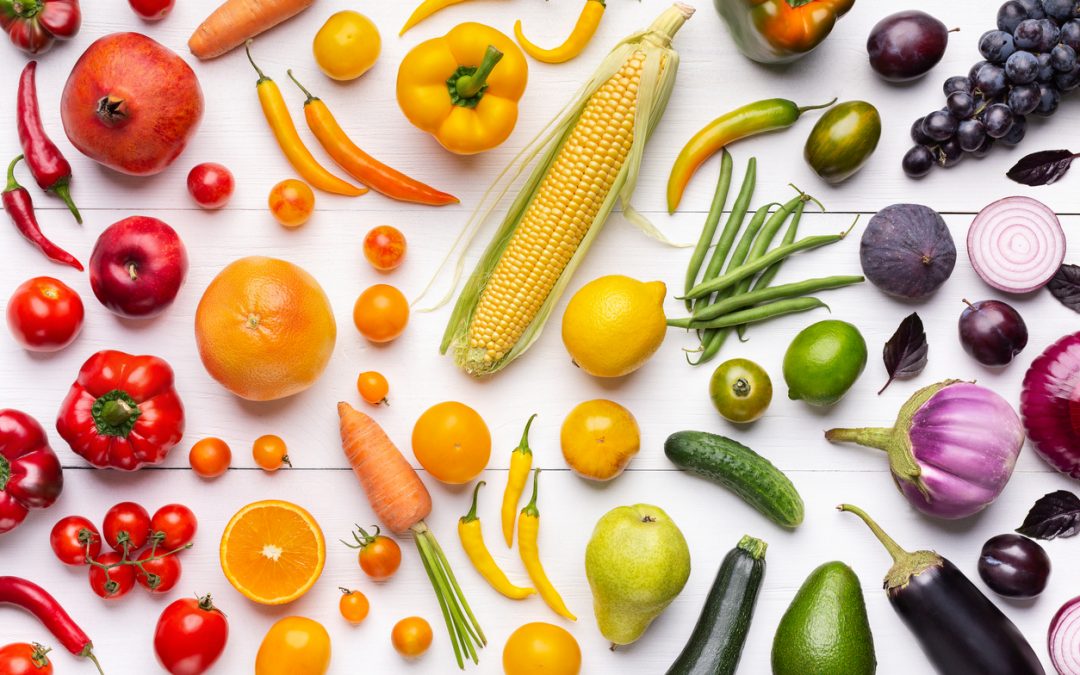
by Jen Owen, N.P. | Jun 24, 2020 | Food Medicine
The Rainbow Diet is something I talk about all the time and it’s the only “diet” I ever recommend. Most traditional diets don’t work, aren’t actually based on science, and generally make people feel deprived and down-right bad about themselves.
When someone comes to see me at my clinic, they’re often not feeling their best. Telling them to stop eating a bunch of different things, limit this or that, or begin exercising vigorously is not always that helpful. People know they need to “eat better” or “start exercising”, but they don’t feel great, and they don’t know where to start.
The Rainbow Diet is the perfect place to start. Just start trying to eat every color of fruit or vegetable every day. It’s way more fun to eat “colors” than to “eat more fruits and vegetables”. Right? And, it’s super fun to shop this way. When you hit the produce department, you add things to your cart based on color. Kids love this too!
Let’s break down each color and discuss the different foods and all the fabulous nutrients you get from each one:
Orange and Yellow:
Orange and yellow fruits and vegetables contain beta-carotene, zeaxanthin, flavonoids, lycopene, potassium, and vitamin C. They are thought to provide many benefits, including: anti-cancer, anti-bacterial, anti-inflammatory, cell protection, heart health, immune health, skin health, brain health, reproductive health, and eye health.
Yellow Foods:
~Apple
~Asian pears
~Bananas
~Bell pepper
~Corn
~Ginger root
~Lemon
~Pineapple
~Starfruit
~Summer squash
Red:
Red fruits and vegetables contain beta carotene, vitamin C, manganese, and lycopene. They are thought to provide many benefits, including anti-cancer, anti-inflammatory, cell protection, gastrointestinal health, heart health, hormone health, and liver health.
Red Foods:
~Apples
~Beets
~Bell peppers
~Blood Oranges
~Cranberries
~Cherries
~Pomegranates
~Red Potatoes
~Radishes
~Raspberries
~Strawberries
~Rhubarb
~Tomato
~Watermelon
Green:
Green fruits and vegetables contain chlorophyll, fiber, lutein, zeaxanthin, calcium, folate, vitamin C, and beta-carotene. They are thought to provide many health benefits, including anti-inflammatory, brain health, cell protection, skin health, hormone health, heart health, and liver and gallbladder health.
Green Foods:
~Apples
~Artichoke
~Asparagus
~Avocado
~Bell peppers
~Bok choy
~Broccoli
~Brussels sprouts
~Cabbage
~Celery
~Cucumbers
~Edamame
~Green beans
~Green peas
~Leafy Greens (arugula, beet, chard, collards, dandelions, kale, green lettuce, mustard, spinach, turnip, watercress)
~Limes
~Okra
~Olives
~Pears
~Snow Peas
~Zucchini
Blue/Purple/Black:
Blue, purple, and black fruits and vegetables contain lutein, zeaxanthin, resveratrol, vitamin C, flavonoids, ellagic acid, and quercetin. They are thought to provide many health benefits, including anti-cancer, anti-inflammatory, cell protection, brain health, heart health, and liver health.
Blue/Purple/Black Foods:
~Bell peppers
~Berries (blue, black, boys, Huckle, and marion)
~Cabbage
~Carrots
~Cauliflower
~Eggplant
~Figs
~Grapes
~Kale
~Olives
~Plums
~Potatoes
~Prunes
~Raisins
White/Tan/Brown:
White, tan, and brown foods contain Vitamin C, Vitamin K, folate, beta-glucans, lignans, and potassium. They are thought to provide many health benefits, including anti-cancer, anti-microbial, cell protection, gastrointestinal health, heart health, hormone health, liver health.
White/Tan/Brown Foods:
~Apples
~Applesauce
~Cauliflower
~Cacoa
~Coconut
~Coffee
~Dates
~Garlic
~Ginger
~Jicama
~Mushrooms
~Onions
~Pears
~Sauerkraut
~Shallots
Plus! Almost all fruits and vegetables are high in fiber, which helps keep the gut lining healthy and helps you absorb and excrete cholesterol, lowering your overall cholesterol levels.
While we may go back and forth about the value of eating many different foods, a high plant-based diet never goes out of style. With so many possible benefits, it’s a no-brainer to try to get in as many colors as you can every day! And, you’ll feel full from all the fresh goodness and you’ll be less likely to be hungry for foods that might not make you feel as optimal.
If you try the rainbow diet and you don’t see results, there may be something else going on. I’d be happy to help you get to the root of your symptoms. Click here to learn more about working with me.
Happy Rainbowing!
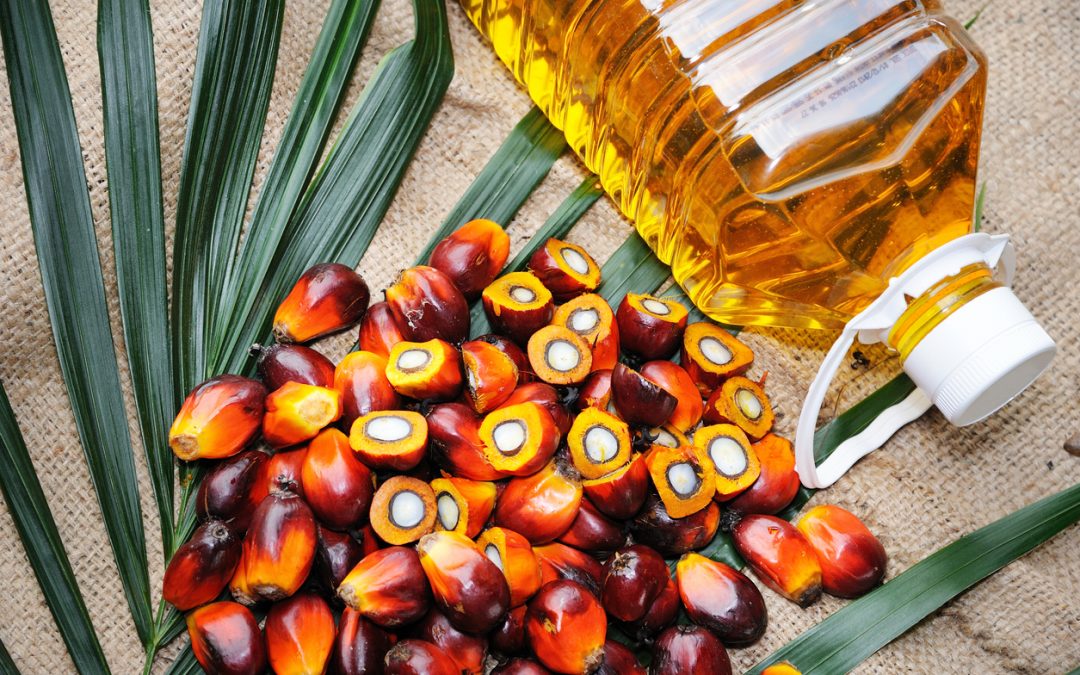
by Jen Owen, N.P. | Jun 12, 2020 | Food Medicine
Did you know that palm oil is the main fat used in over 50% of the products you see in major stores today? It’s used in many processed foods, such as bread, pastries, cereal, peanut butter, chocolate and margarine. It’s also used in personal products like shampoo, cosmetics, cleaning products and even biodiesel fuel. What do you know about this popular fat?
I’ll admit, I knew almost nothing about it. That was until I started having a personal experience with it.
About 10 years ago, I started having issues with my gallbladder. The only option offered to me by my conventional primary care provider was to have my gallbladder removed. I didn’t have stones or other signs of gallbladder disease, I simply had a great deal of inflammation. I knew I could deal with that.
I ate a low fat diet for awhile (the gallbladder is directly involved in the digestion of fats), ate loads of green vegetables and dandelions, used bitters before meals, and took great care of myself overall. And, my symptoms reduced and after several months, I could go back to pretty normal eating.
That was until I started coming into contact with foods that contained palm oil. I noticed it first with a frozen pizza. It caused a full on gallbladder attack. I saw palm oil on the label and just avoided that brand.
Then, about a year ago, my husband went gluten-free for awhile. We bought some gluten-free packaged foods. I munched on a few and boom-another gallbladder attack. And….guess what…palm oil again. I started paying attention to labels and since I generally eat a “real food” diet anyway, it hasn’t been a big deal.
Until, last week. I bought a cake mix for a birthday. I used the mix for ease and made a homemade icing. It was a beautiful cake (if I do say so myself). When I ate it, I had another major gallbladder attack. And once again, a main ingredient was palm oil.
This got me curious. What is up with this oil? I knew it came from the fruit of palm trees. I knew they grind and press the fruit to get the oil. Natural, right?
Well, yes and no. As with all things I get curious about, I started investigating.
I found many articles about palm oil. I found out that after the oil is pressed, it undergoes a fractioning process where the liquid portion is removed by a crystalizing and filtering process. The solid part is then bleached to become the ingredient that is used in so many products here in the U.S.
I learned that palm oil is 50% saturated fat, one of the leading causes of elevated bad cholesterol, a leading cause of heart disease. The main type of saturated fat present in palm oil is palmitic acid. The studies aren’t conclusive yet, but it’s being speculated that palmitic acid is a cause of cardiovascular disease.
During my palm oil studying journey, I came across a film called, “Appetite for Destruction: The Palm Oil Diaries“. Fascinating! Documentary maker, Michael Dorgan does his own personal experiment with palm oil. He ate 3 muffins with palm oil every day for 6 weeks. Body fat analysis and blood tests were performed before and after. Besides the muffins, he ate his regular diet. After the 6 weeks, his total body fat increased from 4.6% to 7.4%. And, the fat accumulation was stored in his abdomen and particularly around his liver. So, the worst kind of fat to store, organ fat.
Now, obviously, a study of one does not quality as good research, yet don’t you think it’s interesting?
And, it started making sense why my gallbladder doesn’t like palm oil.
I would be completely remiss in any discuss of palm oil to not mention the environmental concerns. When the FDA finally got on board with the fact that trans fats are bad, palm oil became even more popular. Palm trees thrive near the equator, just like rainforests. What’s resulting is that forests are being destroyed in order to plant more palm trees to support our need to eat processed foods. Harsh rant and there’s more. Because the rain forests are being destroyed, there’s more carbon in the atmosphere and many species of animals are losing their homes, such as orangutans and certain elephants and rhinos.
The palm oil industry has become a billion dollar industry in the very recent past at the expense of indigenous humans, animals, and the environment, while likely causing those who consume it to progress into cardiovascular health issues.
In summary, eat real foods. Eat foods as close to how they are harvested as possible. Eat local foods. Avoid foods made in factories and you won’t even have to worry about this. I guess I’m lucky to have “my little buddy” aka my gallbladder. It’s there to signal me when I’m doing something sub-optimal for my health and in this case, sub-optimal for the well-being of our whole planet.
I’m still researching and learning about palm oil. If you have any resources or references, I’d love to hear about them. And, if you’re ready to move away from processed foods into more real foods, I’d love to be your guide. I’m currently taking new patients in my integrative primary care practice.

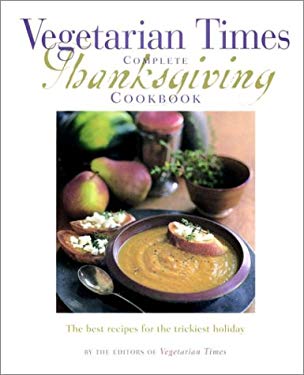
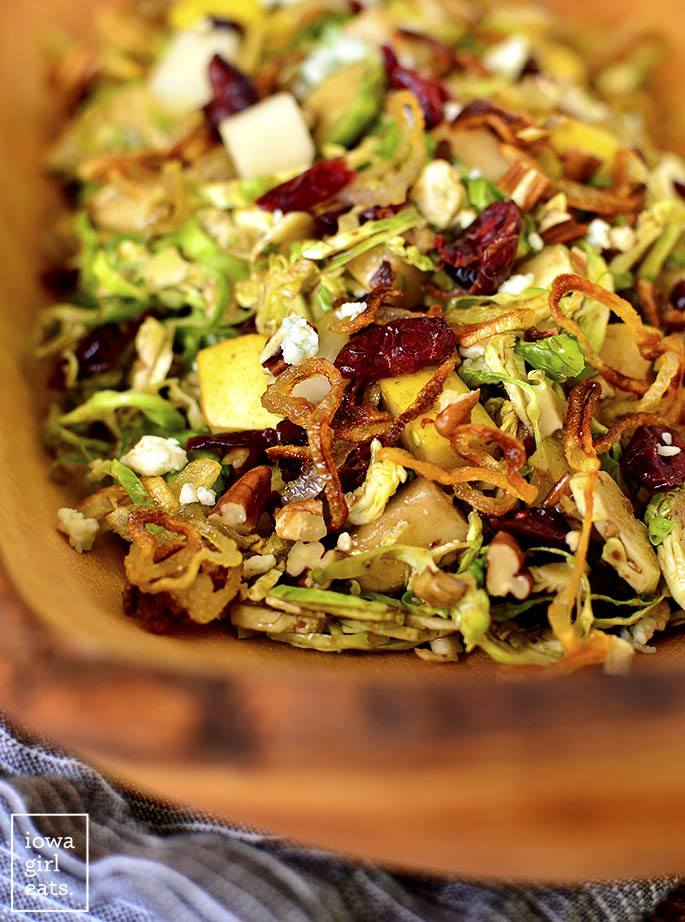
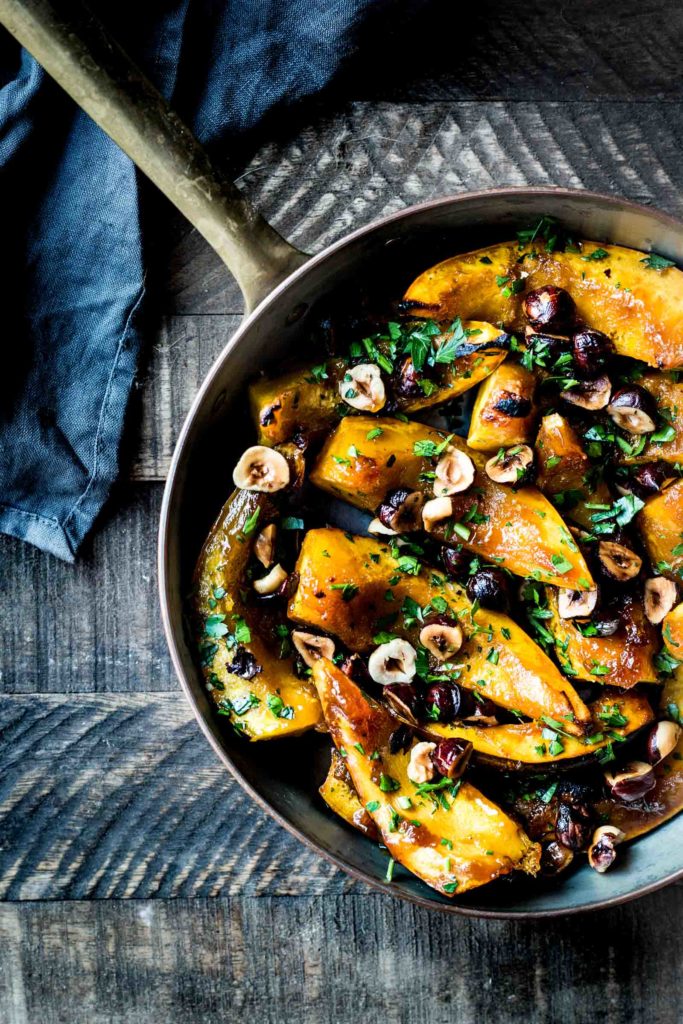
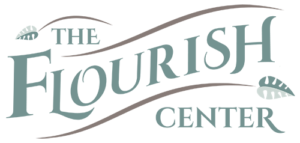




Recent Comments